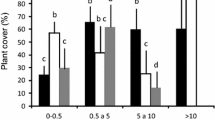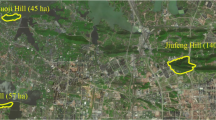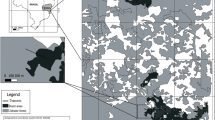Abstract
Forest fragmentation affects seed production, but little is known about how seeds are distributed in fragmented forests after primary dispersion and how this affects their interactions with other organisms. This study addressed these issues in a fragmented oak forest of Quercus laeta where four habitat types were recognized: interior and edge of patches, deforested matrix around patches, and an abandoned field. Areas and distances to the abandoned field were measured for 40 patches, and acorns were sampled in all habitats. Only samples from the interior and edge of patches had acorns, which were classified as aborted, viable, and parasitized by insects or fungi. Acorns in all these classes were regressed against patch area and distance to the abandoned field. Field experiments were also conducted to determine whether acorn removal rates varied across habitats. Aborted acorns within patches were not related to area or distance, but they decreased with increasing values of both variables at patch edges. Within patches, viable acorns were positively related to increases in area and distance, while the converse occurred for insect-damaged acorns; fungal-infested acorns were not related to patch variables in this habitat. Complex interactions between area and distance explained how acorns in these classes were distributed across patch edges. Acorn removal was higher within patches and their edges when compared to human-disturbed habitats; both mice and birds were identified as potential acorn dispersers. These results suggest that forest fragmentation affects acorn-mediated processes and that this may influence the recovery of patch connectivity in the landscape.





Similar content being viewed by others
References
Aalen OO, Borgan Ø, Gjessing HK (2008) Survival and event history analysis: a process point of view. Springer, New York
Acàcio V, Holmgren M, Jansen P, Schrotter O (2007) Multiple recruitment limitation causes arrested succession in mediterranean cork oak systems. Ecosystems 10:1220–1230
Aizen MA, Feinsinger P (1994) Forest fragmentation, pollination, and plant reproduction in a Chaco dry forest, Argentina. Ecology 75:330–351
Arizaga S, Martínez-Cruz J, Salcedo-Cabrales M, Bello-González MA(2009) Manual de la biodiversidad de encinos michoacanos. Secretaría de Medio Ambiente y Recursos Naturales, México
Arroyo-Rodríguez V, Aguirre A, Benítez-Malvido J, Mandujano S (2007) Impact of rain forest fragmentation on the population size of a structurally important palm species: Astrocaryum mexicanum at Los Tuxtlas, Mexico. Biol Conserv 138:198–206
Badano EI (2011) Conservation and restoration of Mexican forests in the global change scenario: a shared responsibility with multiple benefits. Madera y Bosques 17:7–18
Barbeta A, Peñuelas J, Ogaya R, Jump AS (2011) Reduced tree health and seedling production in fragmented Fagus sylvatica forest patches in the Montseny Mountains (NE Spain). For Ecol Manag 261:2029–2037
Bonal R, Muñoz A, Díaz M (2007) Satiation of predispersal seed predators: the importance of considering both plant and seed levels. Evol Ecol 21:367–380
Bonal R, Hernández M, Ortego J, Muñóz A, Espelta JM (2012) Positive cascade effects of forest fragmentation on acorn weevils mediated by seed size enlargement. Insect Conserv Divers 5:381–388
Bonner FT, Vozzo JA (1987) Seed biology and technology of Quercus. USDA Forest Service Gen Tech Rep SO-66, pp 1–21
Borchert MI, Tyler CM (2010) Acorn dispersal of California black oak after a stand-replacing fire. Fire Ecol 6:136–141
Briggs JM, Smith KG (1989) Influence of habitat on acorn selection by Peromyscus leucopus. J Mammal 70:35–43
Buisson E, Dutoit T, Torre F, Römermann C, Poschlod P (2006) The implications of seed rain and seed bank patterns for plant succession at the edges of abandoned fields in Mediterranean landscapes. Agric Ecosyst Environ 115:6–14
Burgos A, Grez AA, Bustamante RO (2008) Seed production, pre-dispersal seed predation and germination of Nothofagus glauca (Nothofagaceae) in a temperate fragmented forest in Chile. For Ecol Manag 255:1226–1233
Bustamante RO, Badano EI, Pickett STA (2012) Impacts of land use change on seed removal patterns of native and exotic species in a forest landscape. Community Ecol 13:171–177
Cadenasso ML, Pickett STA (2000) Linking forest edge structure to edge function: mediation of herbivore damage. J Ecol 88:31–44
Chacoff NP, Morales JM, Vaquera MD (2004) Efectos de la fragmentación sobre la aborción y depredación de semillas en el Chaco Serrano. Biotropica 36:109–117
Collinge SK (2009) Ecology of fragmented landscapes. Johns Hopkins University Press, Baltimore
Crawley MJ, Long CR (1995) Alternate bearing, predator satiation and seedling recruitment in Quercus robur L. J Ecol 83:683–696
de Blois S, Domon G, Bouchard A (2002) Landscape issues in plant ecology. Ecography 25:244–256
DeGange AR, Fitzpatrick JW, Layne JN, Woolfenden GE (1989) Acorn harvesting by Florida scrub jays. Ecology 70:348–356
Delatour C, Morelet M (1979) La pourriture noire desglands. Revue Forestière Française 31:101–115
Dey D (2002) Fire history and postsettlement disturbance. In: McShea WJ, Healy WM (eds) Oak forest ecosystems: ecology and management for wildlife. Johns Hopkins University Press, Baltimore, pp 46–59
Díaz M, Møller AP, Pulido FJ (2003) Fruit abortion, developmental selection and developmental stability in Quercus ilex. Oecologia 135:378–385
Flores-Cano JA, Badano EI, Flores J (2012) Effects of burial depth on seed germination and seedling emergence of Mexican oaks: a glasshouse experiment. Arch Biol Sci 64:1543–1554
García E (1988) Modificaciones al sistema de clasificación climática de Köppen (para adaptarlo a las condiciones de la República Mexicana). Universidad Nacional Autónoma de México, Mexico
García D, Obeso JR, Martínez I (2005) Rodent seed predation promotes differential recruitment among bird-dispersed trees in temperate secondary forests. Oecologia 144:435–446
Gómez JM (2003) Spatial patterns in long-distance dispersal of Quercus ilex acorns by jays in a heterogeneous landscape. Ecography 26:573–584
Gribko LS, Schuler TM, Ford WM (2002) Biotic and abiotic mechanisms in the establishment of northern red oak seedlings: a review. USDA Forest Service Gen Tech Rep NE-295, pp 1–18
Guariguata MR (2005) Restoring tropical montane forests. In: Mansourian S, Vallauri D, Dudley N (eds) Forest restoration in landscapes: beyond planting trees. Springer, New York, pp 298–305
Guzmán-Guzmán J, Williams-Linera G (2006) Edge effect on acorn removal and oak seedling survival in Mexican lower montane forest fragments. New Forest 31:487–495
Haas JP, Heske EJ (2005) Experimental study of the effects of mammalian acorn predators on red oak acorn survival and germination. J Mammal 86:1015–1021
Holl KD, Loik ME, Lin EHV, Samuels IA (2000) Tropical montane forest restoration in Costa Rica: overcoming barriers to dispersal and establishment. Restor Ecol 8:339–349
Hubbard JA, McPherson GR (1999) Do seed predation and dispersal limit downslope movement of a semi-desert grassland/oak woodland transition? J Veg Sci 10:739–744
Jules ES, Rathcke BJ (1999) Mechanisms of reduced Trillium recruitment along edges of old-growth forest fragments. Conserv Biol 13:784–793
Kaplan EL, Meier P (1958) Nonparametric estimation from incomplete observations. J Am Stat Assoc 53:457–481
Kupfer JA, Malanson GP, Franklin SB (2006) Not seeing the ocean for the islands: the mediating influence of matrix-based processes on forest fragmentation effects. Global Ecol Biogeogr 15:8–20
Kutner MH, Nachtsheim CJ, Neter J, Li W (2005) Applied linear statistical models. McGraw-Hill/Irwin, New York
Lee ET, Desu MM, Gehan EA (1975) A Monte Carlo study of the power of some two-sample tests. Biometrika 62:425–432
Llorente-Bousquets J, Ocegueda S (2008) Estado del conocimiento de la biota. In: Sarukhán J, Soberón J, Halffter G, Llorente-Bousquets J (eds) Capital Natural de México, vol I. Comisión Nacional para el Conocimiento y Uso de la Biodiversidad, México, pp 283–322
Lomolino MV, Perault DR (2004) Geographic gradients of deforestation and mammalian communities in a fragmented, temperate rain forest landscape. Global Ecol Biogeogr 13:55–64
López-Barrera F, Newton A (2005) Edge type effect on germination of oak tree species in the Highlands of Chiapas, Mexico. Forest Ecol Manag 217:67–79
Lord JM, Norton DA (1990) Scale and the spatial concept of fragmentation. Conserv Biol 4:197–202
Martínez ML, Pérez-Maqueo O, Vázquez G, Castillo-Campos G, García-Franco J, Mehltreter K, Equihua M, Landgrave R (2009) Effects of land use change on biodiversity and ecosystem services in tropical montane cloud forests of Mexico. Forest Ecol Manag 258:1856–1863
Martínez-Chaves PA, Betancourt-Mendieta A, Caretta MN, Aguilar-Robledo M (2010) Procesos históricos y ambientales en Cerro de San Pedro, San Luis Potosí, México, 1948-1997. Región y Sociedad 22:211–241
McClanahan TR, Wolfe RW (1993) Accelerating forest succession in a fragmented landscape: the role of birds and perches. Conserv Biol 7:279–288
Moore JE, McEuen AB, Swihart RK, Contreras TA, Steele MA (2007) Determinants of seed removal distance by scatter-hoarding rodents in deciduous forests. Ecology 88:2529–2540
Muñoz A, Bonal R (2011) Linking seed dispersal to cache protection strategies. J Ecol 99:1016–1025
Nixon KC (1993) Infrageneric classification of Quercus (Fagaceae) and typification of sectional names. Ann Sci For 50:25–34
Nupp TE, Swihart RK (2000) Landscape-level correlates of small mammal assemblages in forest fragments of farmland. J Mammal 81:512–526
Pedraza-Montes JF (1994) Sinopsis histórica del municipio de Cerro de San Pedro del estado de San Luis Potosí. Centro de Desarrollo Municipal, San Luis Potosí
Perea R, San Miguel A, Martínez-Jauregui M, Valbuena-Carabaña M, Gil L (2012) Effects of seed quality and seed location on the removal of acorns and beechnuts. Eur J Forest Res 131:623–631
Ponce de Leon-García L (2005) Ecofisiologia de los frutos de Quercus sartorii y Quercus germana. In: Sanchez-Ramos G, Reyes-Castillo P, Dirzo R (eds) Historia natural de la Reserva de la Biósfera El Cielo, Tamaulipas. Universidad Autónoma de Tamaulipas, México, pp 280–289
Pulido FJ (2002) Biología reproductiva y conservación: el caso de la regeneración de bosques templados y subtropicales de robles (Quercus spp.). Rev Chil Hist Nat 75:5–15
Pulido FJ, Díaz M (2002) Dinámica de la regeneración natural del arbolado de encina y alcornoque. In: Pulido FJ, Campos-Palacín P, Montero-González G (eds) La gestión forestal de las dehesas. Instituto del Corcho, la Madera y el Carbón Vegetal, Mérida, pp 39–62
Pulido FJ, García E, Obrador JJ, Montero MJ (2005) Effects of management on acorn production and viability in holm oak dehesas. In: Mosquera-Losada RM, McAdam J, Rigeiro-Rodríguez A (eds) Silvopastoralism and sustainable land management. CABI, Wallingford, pp 180–181
Ries L, Robert JF, Battin J, Sisk TD (2004) Ecological responses to habitat edges: mechanisms, models, and variability explained. Ann Rev Ecol Evol Syst 35:491–522
Rizkalla CE, Swihart RK (2007) Explaining movement decisions of forest rodents in fragmented landscapes. Biol Conserv 140:339–348
Rocha OJ, Aguilar G (2001) Reproductive biology of the dry forest tree Enterolobium cyclocarpum (guanacaste) in Costa Rica: a comparison between trees left in pastures and trees in continuous forest. Am J Bot 88:1607–1614
Sala OE, Stuart F, Armesto JJ, Berlow E, Bloomfield J, Dirzo R, Huber-Sanwald E, Huenneke LF, Jackson RB, Kinzig A, Leemans R, Lodge DM, Mooney HA, Oesterheld M, Poff NL, Sykes MT, Walker BH, Walker M, Wall DH (2000) Global biodiversity scenarios for the year 2100. Science 287:1770–1774
Santos T, Tellería JL (2006) Pérdida y fragmentación del hábitat: efecto sobre la conservación de las especies. Ecosistemas 15:3–12
Santos BA, Arroyo-Rodríguez V, Moreno CE, Tabarelli M (2010) Edge-related loss of tree phylogenetic diversity in the severely fragmented Brazilian Atlantic forest. PLoS ONE 5:e12625
Saunders DA, Hobbs RJ, Margules CR (1991) Biological consequences of ecosystem fragmentation: a review. Conserv Biol 5:18–32
Shaw MW (1968) Factors affecting the natural regeneration of sessile oak (Quercus petraea) in North Wales: I. A preliminary study of acorn production, viability and losses. J Ecol 56:565–583
Shiels AB, Walker LR (2003) Bird perches increase forest seeds on Puerto Rican landslides. Rest Ecol 11:457–465
Smallwood PD, Steele MA, Faeth SH (2001) The ultimate basis of the caching preferences of rodents, and the oak-dispersal syndrome: tannins, insects, and seed germination. Am Zool 41:840–851
Steele MA, Smallwood PD (2002) Acorn dispersal by birds and mammals. In: McShea WJ, Healy WM (eds) Oak forest ecosystems: ecology and management for wildlife. Johns Hopkins University Press, Baltimore, pp 182–195
Studnicki-Gizbert D, Schecter D (2010) The environmental dynamics of a colonial fuel-rush: silver mining and deforestation in New Spain, 1522 to 1810. Environ Hist 15:94–119
Swiecki TJ, Bernhardt EA, Arnold RA (1991) Insect and disease impacts on blue oak acorns and seedlings. USDA Forest Service Gen Tech Rep PSW-126, pp 149–155
Tellería JL, Santos T, Alcántara M (1991) Abundance and food-searching intensity of wood mice (Apodemus sylvaticus) in fragmented forests. J Mammal 72:183–187
Vesk PA, Davidson A, Chee YE (2010) Spatial distribution and prediction of seed production by Eucalyptus microcarpa in a fragmented landscape. Austral Ecol 35:60–71
Zavala-Chavez F (2004) Desecación de bellotas y su relación con la viabilidad y germinación en nueve especies de encinos mexicanos. Ciencia Ergo Sum 11:177–185
Zavala-Chávez F, García E (1996) Frutos y semillas de encinos. Universidad Autónoma Chapingo, Texcoco
Acknowledgments
We especially thank to Eduarda Muñoz and her family for the support they provided us during the development of this study. Juan Pablo Rodas, Claudia González and Omar Samour are acknowledged by their collaboration in the field work. We also acknowledge the comments of two anonymous reviewers that helped to improve the earlier version of this manuscript. This was partially founded by IPICYT and project PROMEP/103.5/11/3671 to JAFC.
Author information
Authors and Affiliations
Corresponding author
Additional information
Communicated by J. Müller.
Electronic supplementary material
Below is the link to the electronic supplementary material.
Rights and permissions
About this article
Cite this article
Ramos-Palacios, C.R., Badano, E.I., Flores, J. et al. Distribution patterns of acorns after primary dispersion in a fragmented oak forest and their consequences on predators and dispersers. Eur J Forest Res 133, 391–404 (2014). https://doi.org/10.1007/s10342-013-0771-5
Received:
Revised:
Accepted:
Published:
Issue Date:
DOI: https://doi.org/10.1007/s10342-013-0771-5




